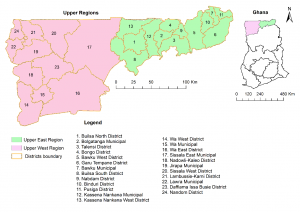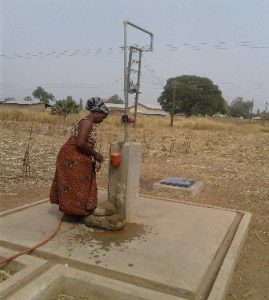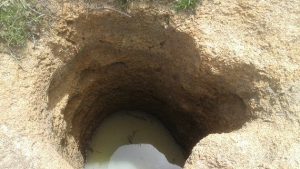
August 28, 2019, by lzzeb
To achieve ‘safely managed water’ for all by 2030, the Joint Monitoring Programme must monitor seasonality in faecal contamination of drinking water sources
A blog by Alfred Dongzagla, Third Year Ph.D. Student
Target 6.1 of the Sustainable Development Goal seeks to achieve universal and equitable access to safe and affordable drinking water for all by 20301, with the indicator being access to ‘safely managed water’.2 The WHO/UNICEF Joint Monitoring Programme defines ‘safely managed water’ as a drinking water source that is located on premises, available when needed and free from faecal and priority chemical contamination.2 This definition encapsulates three important aspects of drinking water supply – quality, accessibility and reliability. Although the elements of safely managed water are multidimensional, monitoring is presently cross sectional, and thus masks seasonal effects in water supply. To help illuminate this in water scholarship, my PhD research, in part, investigated seasonal variations in faecal contamination of drinking water sources in the Upper Regions of Ghana.
The Upper Regions of Ghana consists of the Upper West and Upper East Regions. The two regions are located in the upper most part of Ghana (Fig. 1) with a total population of 1,748,655 and a landmass of 27,318 km2. The choice of the Upper Regions of Ghana for the study was informed by two main reasons. Foremost, the study was conducted in Ghana so that the sponsor – Government of Ghana – would benefit directly from the findings. Secondly, surface and groundwater sources in the regions are at risk of faecal contamination due to high open defecation, insanitary latrine designs and open dumping of refuse.
Field data collection took place in Ghana from June 2017 to March 2018 with two of the 24 Districts/Municipalities in the Upper Regions randomly sampled for data collection: Jirapa and Kassena-Nankana. Faecal matter was tested in drinking water sources using 3M Petrifilm Coliform Count Plates with the Faecal Indicator Bacteria (FIB) being Faecal Coliform (also known as Thermotolerant Coliform). In the rainy season, 141 water samples, from five different source types were tested. The test was repeated in the dry season. However, 13 water sources were non-functional in the dry season and thus could not be tested.
From the results, households in the study area depend on not only improved water sources but unimproved sources as well for domestic use. Their main sources of drinking water were pipe-borne (i.e. piped water into compound), standpipes, boreholes, protected hand-dug wells, unprotected hand-dug wells and dugouts/dams. Of the 568 households surveyed, 91.8% relied on boreholes, 2.3% on pipe-borne water on compound, 1.7% on protected hand-dug wells, 1.7% on unprotected hand-dug wells, 1.3% on standpipes and 1.2% on dugouts/dams for domestic use. Improved3 water coverage was estimated to be 97.4%.
Analysis of descriptive statistics revealed higher faecal coliform concentrations in the rainy season than in the dry season. The average concentration in the rainy season (44.5 CFU4/mL) was three times higher than in the dry season (12.2 CFU/mL). Also, the maximum concentration recorded in the rainy season was 200 CFU higher than in the dry season. A Wilcoxon Signed Rank test shows that the observed differences were significant (z = -0.53, p < 0.05, r = -0.41). This implies that the JMP and water surveillance bodies (e.g Multiple Indicator Cluster Survey, Demographic Health Survey and Living Standard Measurement Survey) risk overestimating the population with access to safe water in Ghana and similar countries if seasonality in water quality is not monitored.
The proportion of drinking water sources that failed to comply with the WHO guideline of free faecal coliforms was 27.3% in the dry season. It increased to 51.8% in the rainy season with 27.7% of drinking water sources having high (11-100 CFU/mL) to very high (>100 CFU/mL) levels of faecal coliforms. Non-compliance of improved water sources in the dry and rainy seasons were 26.2% and 48.5%, respectively. Regardless of season, unimproved water sources recorded 100% non-compliance. A range of factors was identified as potential causes of faecal contamination of drinking water sources in the study area. Major among them are open defecation, insanitary latrines, open dumping of refuse, pipe leakages and lack of disinfection of wells.
- United Nations. (2015). Transforming Our World: The 2030 Agenda for Sustainable Development. A/RES/70/1. Retrieved from: https://sustainabledevelopment.un.org/content/documents/21252030%20Agenda%20for%20Sustainable%20Development%20web.pdf.
- WHO/UNICEF Joint Monitoring Programme. (2015). JMP Green Paper.: Global Monitoring of Water, Sanitation and Hygiene Post 2015. Retrieved from: http://www.wssinfo.org/fileadmin/user_upload/resources/JMP-Green-Paper-15-Oct-2015.pdf.
- The term improved water sources refers to water sources, which by the nature of their construction are protected from outside contamination, especially faecal coliforms. They include pipe borne water, public tap/stand pipe, tube well/borehole, protected well, protected spring, rainwater, tanker supplied, and packaged water.
- Colony Forming Unit
No comments yet, fill out a comment to be the first




Leave a Reply